We return to Indonesia to Makassar, the busy capital city of South Sulawesi. Being the largest city of Sulawesi, it is a bustling city with a very busy modern airport connecting flights from West Indonesia to the Eastern end of the volcano laden country. It is also home to one of Indonesia’s largest ethnic group, the Buginese or Bugis, renowned in regional history as strong-willed, courageous adventurers living the life of seafarers, boat builders, influential leaders, and even, being tyrannical pirates.
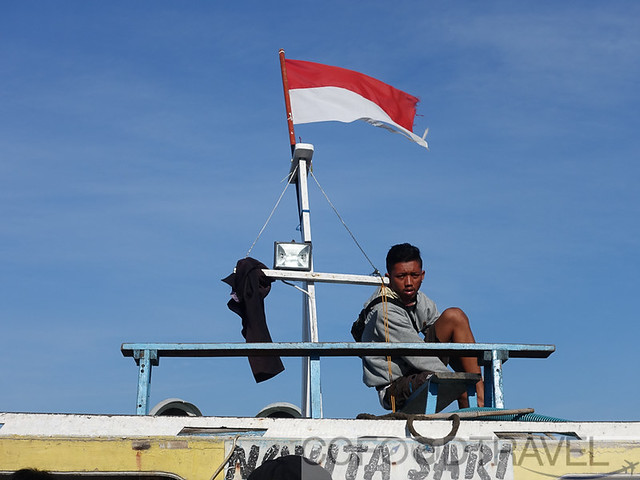
Sulawesi was formerly known as Celebes Island, a name derived from the Portuguese word, Celebres, or Celebration. As a young kid, I’ve always been fascinated by the name Celebres. Maybe it is its unique shape of the island which has four distinctive peninsulas creeping out of its central region.

Formed by the amalgamation of the word Sula (Island) and Besi (Iron), Sulawesi is the 11th largest island in the world – even larger than Java. You might have already known about its famous dive destinations of Togian Islands, Wakatobi Marine Park, Lembeh Strait and Bunaken National Park. Diverse marine species and beautiful underwater landscapes await any scuba dive enthusiasts. If diving is not one’s interest, there are national parks like Tangkoko National Park where one can go in search of hundreds of endemic wildlife such as the Crested Black Macaque, Sulawesi Dwarf Cuscus, Babirusa and Spectral Tarsier. If anthropology rocks your loins, the practice of Aluk To Dolo or the ‘Way of the Ancestors’ by Toraja people in highlands near the city of Rantepao will surely give you tremendous pleasure. The Torajan hold elaborate funeral rites, bury the dearly departed on steep rocky cliffs, and built ancestral houses with oversized roofs called tongkonan.
Sulawesi is divided into six provinces: Gorontalo, West Sulawesi, South Sulawesi, Central Sulawesi, Southeast Sulawesi and North Sulawesi. On this visit, instead of stepping into the aforementioned key attractions, we went on the well trodden path taken by local Indonesians on their travels when they visit Makassar. Here are five things you can do when visiting.
1. Fort Rotterdam
If you are walking around Makassar, you would probably find your way into Fort Rotterdam, a 17th century Dutch bastion built on an existing fort of the Gowa Kingdom, Jum Pandan. This ancient name had also been re-interpreted as Ujung Pandang, another name for the city of Makassar.

Though we didn’t stay long enough to explore the entire Dutch styled architecture here with its clean line structures and a well manicured garden, we were told the museum is a great place to start as it holds many artifacts and jewelry of importance from ancient times.
2. Kodingareng Keke and Samalona Island


Kodingareng Keke is an uninhabited tiny island popular with locals on the weekends. The sandbar island is just about an hour and half away by boat from Kayu Bangkoa Jetty, located near Fort Rotterdam. A private boat hire will cost about IDR500,000 depending on boat size and tour complexity. There are no island entrance fees.
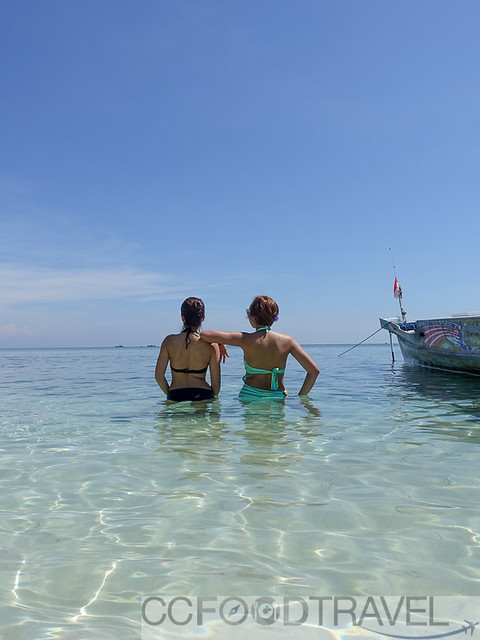
There isn’t much to do here except snorkel, sunbathe, scuba dive, have a picnic or capture lots of dramatic Instagram poses with the clear turquoise waters as your backdrop. No pokemons here last time I checked. Mobile data network is weak to non-existent.
Marine life isn’t the healthiest but if you manage your expectations, Kodingareng Keke will surely be enjoyable.

There are no food nor drinks sold on Kodingareng Keke (neither is there a toilet!). You will need to bring your own picnic basket, or add to your program a visit to Samalona Island, another small island which is inhabited that offers beaches, village life, convenience stores, hot cooked food, and short-term accommodation. Samalona is a half hour boat ride on the return journey from Kodingareng.

Samalona Island
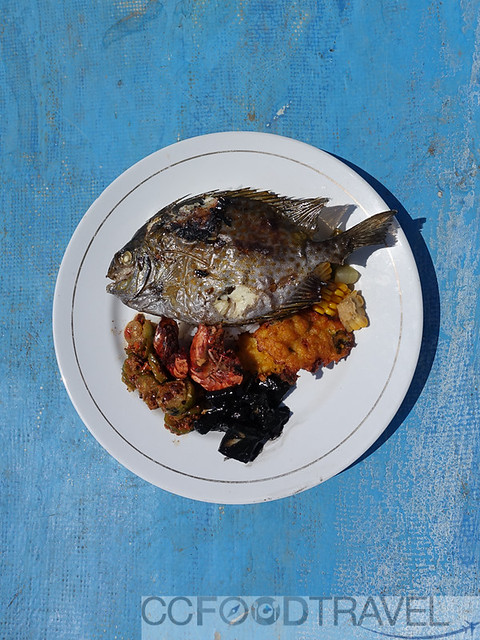
Hot fresh cooked seafood served at Samalona
3. Bantimurung Waterfall
Bantimurung Bulusaraung National Park is located 50km north of Makassar in the Maros Regency. At 43,750 hectares, the park is very large. The key attractions here are Bantimurung Waterfall which includes a water park, endemic butterfly species and a karst landscape that happens to be the second largest in the world after the South China Karst.
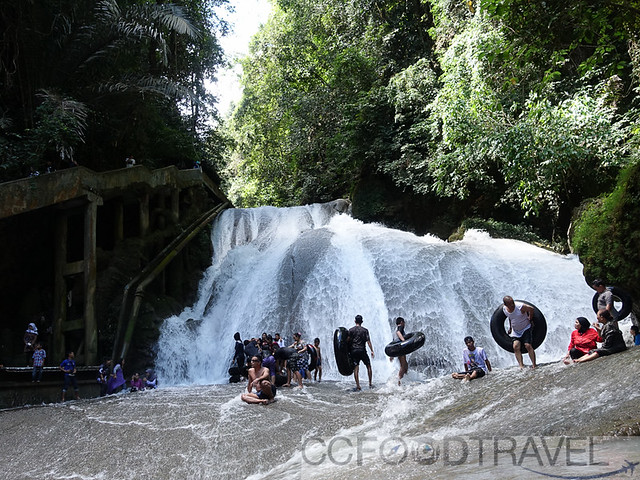
On this trip we only visited the Bantimurung Waterfall area. It is a popular park and weekends would not be best time to visit. Entrance fee for foreigners is IDR225,000 while locals get the benefit paying only IDR25,000


Also open to the public is a small cave which is more like a grotto about 20 minutes walk further away from the waterfall. You can bring along your own torchlight or rent one at the cave entrance.

After visiting the cave, our park guide offered to take us off the beaten path to a hidden lake through the karst forest, a small waterfall and a cave chamber. The trail requires shoes with good traction, and being surefooted so if you were offered the same opportunity, best be equipped.
While one can view part of the karst at the waterfall area, the best opportunity to view the formations together with a boat ride (for a fee and with entrance charges) is Rammang Rammang which is about 22km away or 45 minutes drive away. Sadly, we didn’t have time for this.
4. Eat the popular local delicacies: Coto Makassar, Pallubasa, Konro, Es Pisang Ijo, Jalangkote and Ikan Bakar with Parape
Makassar surprised us with its culinary offerings. We sampled several must-eats here and we are a fan now.

If you are a red meat fan, Pallubasa will surely win you over. This a hearty stew made by boiling all the parts of the cow or a buffalo. The hot thick moreish broth is served with cuts of offal and meat with the option of a raw yolk added prior to serving for more nutrition and plate esthetics. The taste is absolutely divine. Whatever meat gaminess, if any, had been ‘neutralised’ by the spice and herb broth. We ate this dish at Pallubasa Serigala (Wolve) which happens to be the ultimate place to taste this dish.


Udderly tasty!
We were told Pallubasa resembles two other distinctive Makassar meat based stews, Coto Makassar and Konro. Each of the dishes uses similar ingredients (or what Indonesians refer to as bumbu) such as coriander, nutmeg, turmeric, galangal, cinnamon, tamarind, lemongrass, clove, candlenut, and salam leaf but in different measures. What distinguishes each one is minor but adds a different dimension to the finished dish. Rawon recipe adds the ‘poisonoua’ kluwak (keluwak) nuts, and is served with ribs. Coto Makassar has ground peanuts, and served with Burasa (a boiled rice cake infused with coconut milk) or Ketupat (regular boiled rice cake with no added flavours). Pallubasa is served with roasted dessicated coconut, and eaten with regular rice.
At the popular Rumah Makan Muda Mudi, we tasted several Makassarese staples.

Es Pisang Ijo is an odd Makassarese dessert. Literally translated as Ice Green Banana, the cold dessert has a steamed banana wrapped in a green rice dough swimming in red cocopandan sauce and drenched with coconut milk and sweetened condensed milk. Sweet, stodgy and dense, it wasn’t a hit with me but many Indonesians sure love it.
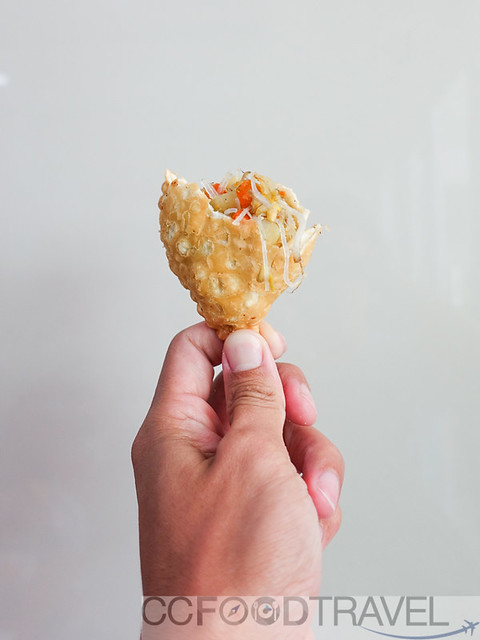
Jalangkote
From appearance Jalangkote resembles an empanada, samosa, pastel or a curry puff but the filling is different for this Makassar favourite. The puff pastry is usually filled with carrots, potatoes, vermicelli, bean sprouts, celery and spring onions, then fried to golden brown for a crunchy, crispy bite. Popular with all Indonesians, this savoury snack isn’t my favourite. Maybe we are just too used to potatoes, curry flavors and meat in these type of pastries.
We love seafood and Rumah Makanan Bahari seems to have cooked it right to win us over. We ate some of the tastiest seafood right here.
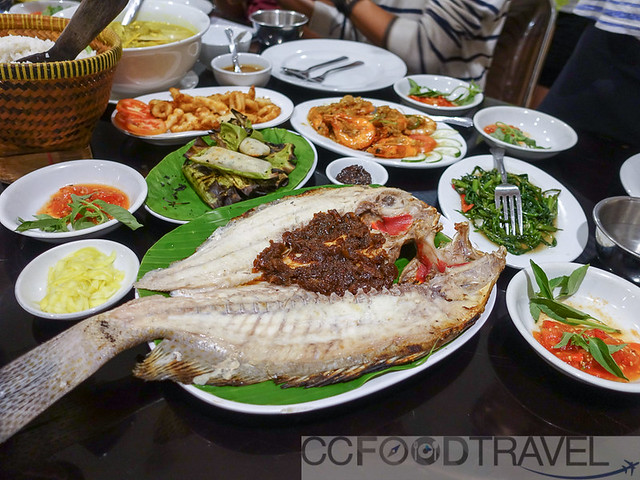
Amongst the seafood served, the grilled Baronang fish (Rabbitfish) was the standout. The fish, butterflied then grilled on skin side was perfectly cooked with succulent flesh that could be eaten on its own, or with a dash of sambal parape condiment for that sweet sour spicy pungent flavor of sauteed red onions, tamarind and whatever secret spices added.
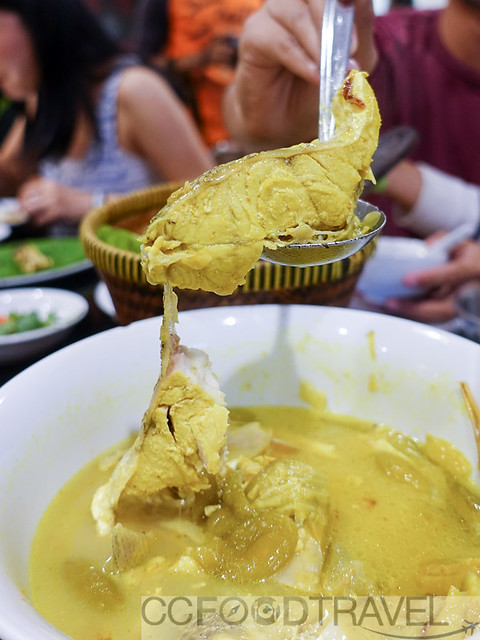
Palumara Ikan Tongkol (Tuna Mackerel), a tumeric based fish dish. Another distinctive Makassar favourite.
5. Sunset at Pantai Losari
Before leaving Makassar, spend an evening out at Pantai Losari to watch the sunset then saunter over to the food stalls that line the busy coastal road to feast on a variety of Indonesian dishes.
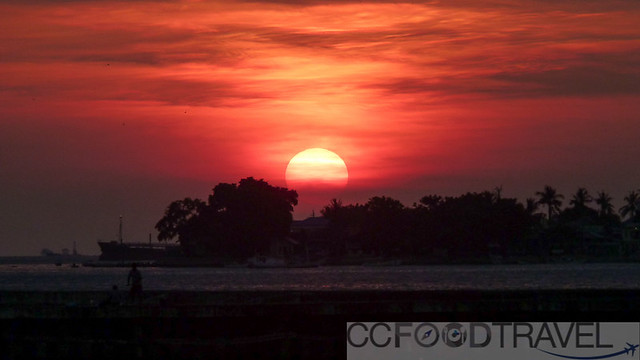
This image shot with Panasonic

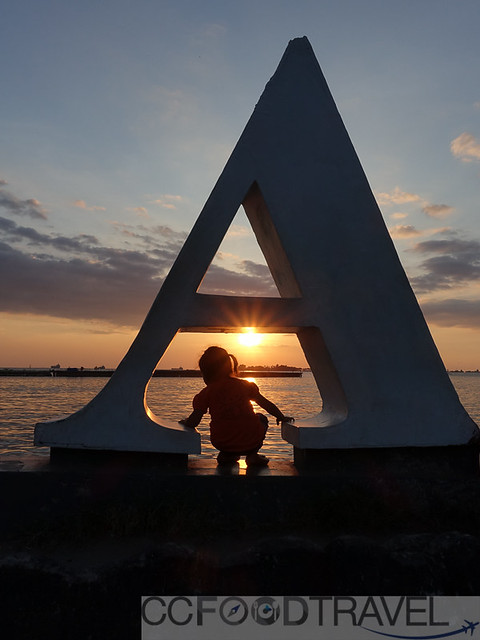
This trip was sponsored by Tourism Indonesia. CCFoodTravel maintains full editorial control of the content published on this site as always.
All images shot by us are captured using Sony DSC-RX100IV






This place is stunningly beautiful, so very exotic, so very interesting. Sure beats visiting the modern cities – you’ve seen one, you’ve seen them all.
Sulawesi like the rest of Indonesia is unique. Whether its the cities, towns, the people, or the natural attractions, there is always something new to appreciate
Fascinated by Makassar
do visit it 🙂